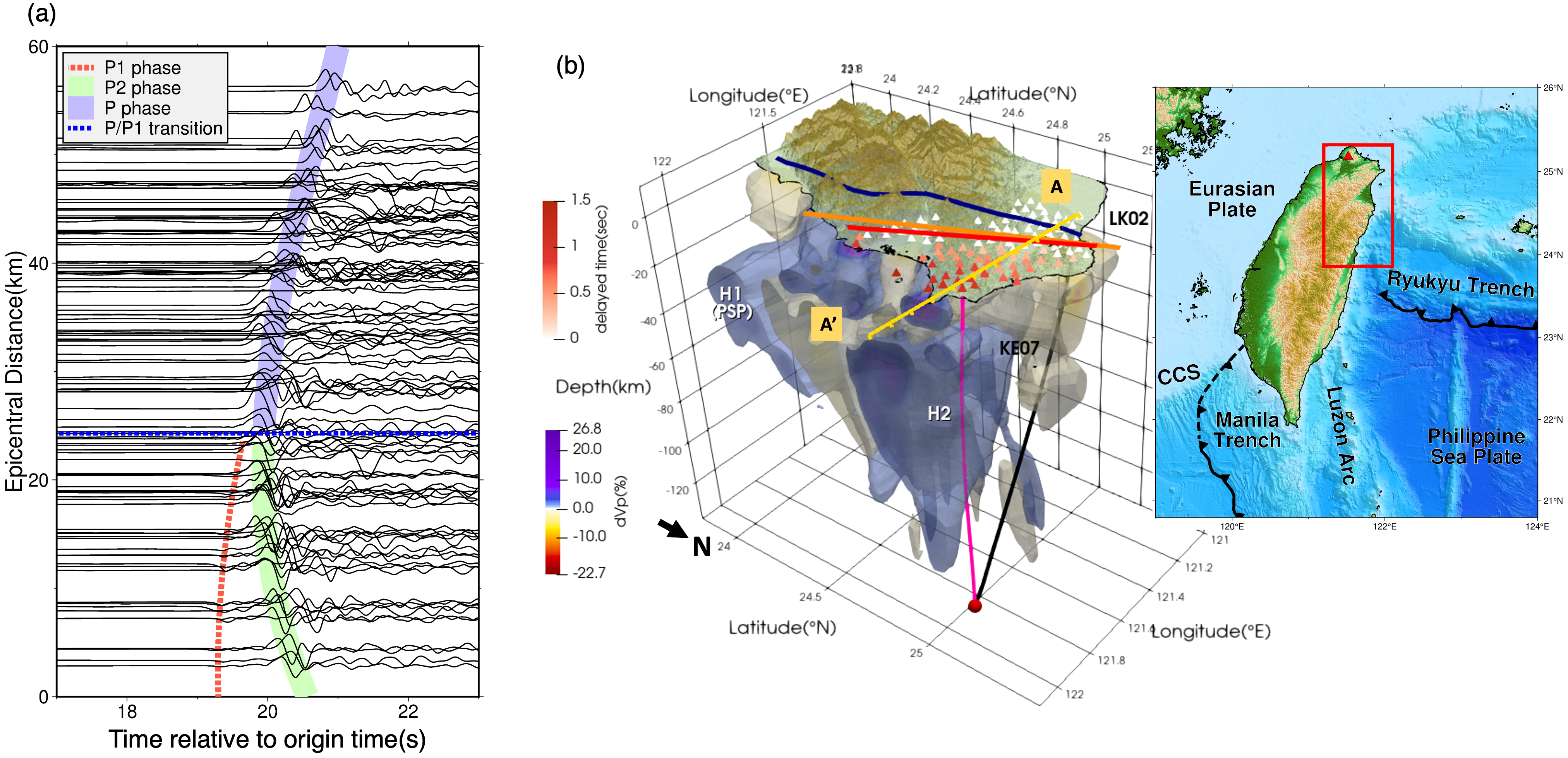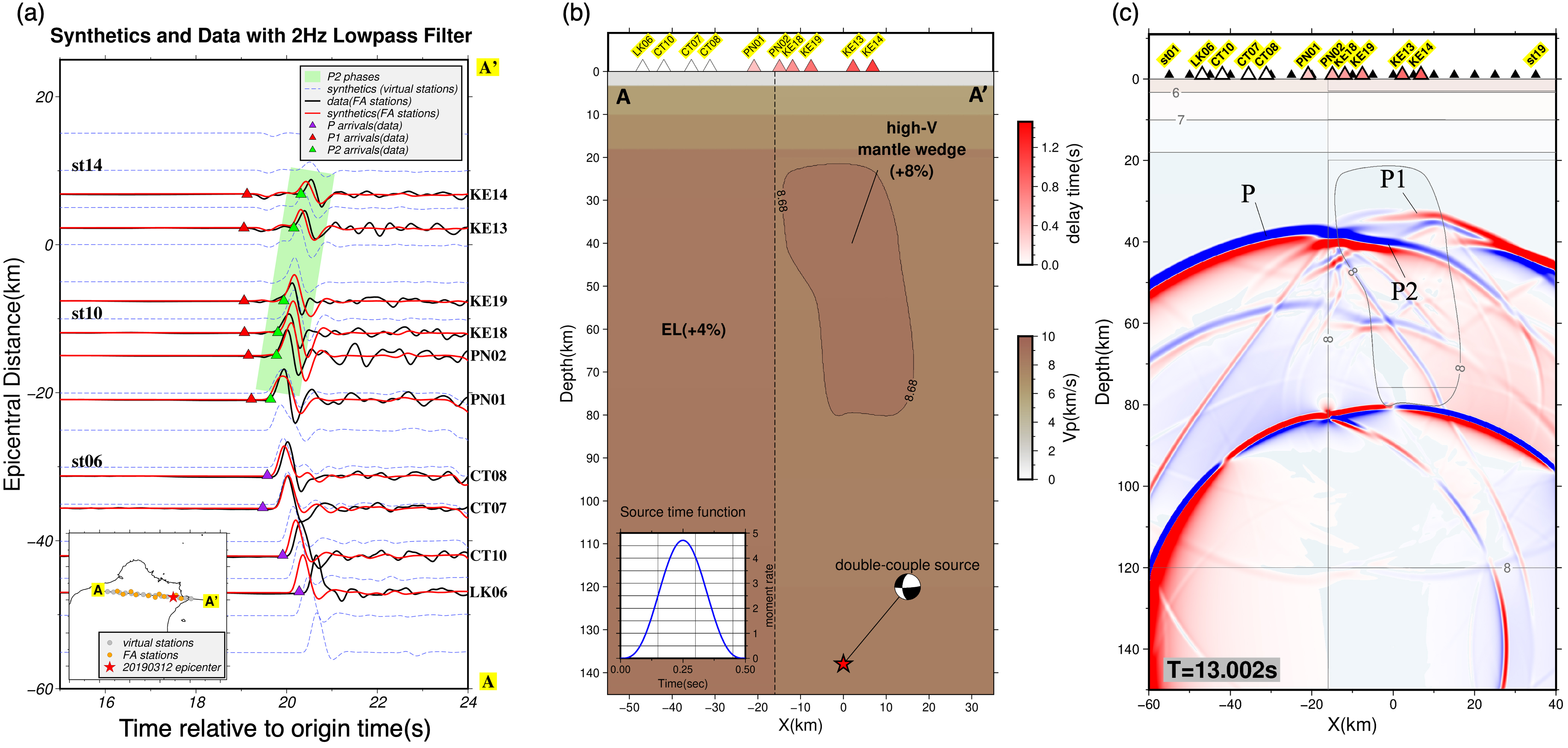以二維地震波模擬探討臺灣東北部雙重P波之觀測
顏宏宇1, 2、陳伯飛1
1國立中央大學地球科學系
2中央研究院國際研究生學程(TIGP)
福爾摩沙陣列(FA)所記錄到台灣東北部深源地震(深度~50-150公里)的雙重直達P波已有發表與解釋(Lin et al., 2019, 2021),本研究針對此觀測的代表地震(2019/03/12)資料(圖一)進行分析及二維地震波模擬(OpenSWPC, Maeda et al., 2017) (圖二a),並提出另類解釋。初始速度的主要結構有二(圖二b):(一) 琉球隱沒帶上方地函楔中的高Vp異常(Su et al., 2019),(二) 在地函楔西側設置了稍高的Vp歐亞大陸岩石圈(Huang et al., 2014),並帶有一個近垂直邊界(Eurasian–Philippine Plate Boundary, EPB)。
經由試錯法修正細部速度構造後,我們可以複刻跟完整觀測波形特徵一致的模擬結果從而得到以下結論(圖二c):(A) P1是向上、向東輻射經過結構(一)傳播至地表的能量,因輻射方位靠近震源機制節點而震幅小,(B) P2是沿著EPB傳播的首波(head wave),再以相同臨界角向東輻射的能量,(C) P是向上、向西輻射穿過歐亞大陸岩石圈傳播至地表的能量。
此結論也說明同為向西輻射的P、P2有類似相位,而P1的相位幾近相反。雙重P波與單一P波的邊界代表EPB投射在的地表的位置(圖一a)。我們也對附近深源地震進行模擬,本研究的二維模型也大致足以解釋周遭其他地震雙重P波的觀測。(Yen et al., 2022)

圖一、(a) 2019/03/12事件在所有FA陣列隨著不同震央距所記錄到的垂直位移,標記了P、P1和P2,以顯示由藍色虛線分隔的不同初達波到達模式。(b) 採用Su et al. (2019)的高解析度北台灣地下三維P波速度異常圖,其中H1和H2分別表示PSP板塊和地函楔中的高Vp異常。圓圈表示地震震源位置。三角形表示具有P1-P2延遲時間且以顏色標示的FA測站分佈。黃色線條:波形模擬的二維剖面(AA')。紅色線條:由P1-P2零延遲時間測站表示的EUP-PSP邊界。橙色線條:來自Ko et al. (2012)的PSP板塊西北端面投影。藍色線條:與橙色線條相同,但來自Wu et al. (2009)。右上角子圖:台灣的構造背景。紅框標示研究區域。

圖二、(a) 沿著AA'剖面測站的觀測波形(黑色)和合成波形(紅色) (震央距向右為正)。淺藍軌跡表示虛擬測站的合成波形。P、P1和P2相的到時分別以紫色、紅色和綠色三角形標示。插圖:AA'剖面圖,顯示震央、實際FA測站和虛擬測站的位置。(b) 最佳的速度結構用於二維波形模擬,以重現沿AA'剖面的觀測結果。主要的非均質特徵包括高速度的地函楔(實線)和EPB(虛線)。地震源輻射機制和震源時間函數分別顯示在右下角和左下角。(c) 地震發生後13秒的波傳播快照。對應波相(P、P1和P2)的波前已標記。
參考文獻
Huang, H.-H., Wu, Y.-M., Song, X., Chang, C.-H., Kuo-Chen, H., & Lee, S.-J. (2014). Investigating the lithospheric velocity structures beneath the Taiwan region by nonlinear joint inversion of local and teleseismic P wave data: Slab continuity and deflection. Geophysical Research Letters, 41(18), 6350–6357. https://doi.org/10.1002/2014GL061115
Ko, Y.-T., Kuo, B.-Y., Wang, K.-L., Lin, S.-C., & Hung, S.-H. (2012). The southwestern edge of the Ryukyu subduction zone: A high Q mantle wedge. Earth and Planetary Science Letters, 335–336, 145–153. https://doi.org/10.1016/j.epsl.2012.04.041
Lin, C.-H., Shih, M.-H., & Lai, Y.-C. (2019). A Strong Seismic Reflector within the Mantle Wedge above the Ryukyu Subduction of Northern Taiwan. Seismological Research Letters, 91(1), 310–316. https://doi.org/10.1785/0220190174
Lin, C.-H., Shih, M.-H., & Lai, Y.-C. (2021). Mantle wedge diapirs detected by a dense seismic array in Northern Taiwan. Scientific Reports, 11(1), 1561. https://doi.org/10.1038/s41598-021-81357-7
Maeda, T., Takemura, S., & Furumura, T. (2017). OpenSWPC: an open-source integrated parallel simulation code for modeling seismic wave propagation in 3D heterogeneous viscoelastic media. Earth, Planets and Space, 69(1), 102. https://doi.org/10.1186/s40623-017-0687-2
Su, P.-L., Chen, P.-F., & Wang, C.-Y. (2019). High‐Resolution 3-D P Wave Velocity Structures Under NE Taiwan and Their Tectonic Implications. Journal of Geophysical Research: Solid Earth, 124(11), 11601–11614. https://doi.org/10.1029/2019JB018697
Wu, F. T., Liang, W.-T., Lee, J.-C., Benz, H., & Villasenor, A. (2009). A model for the termination of the Ryukyu subduction zone against Taiwan: A junction of collision, subduction/separation, and subduction boundaries. Journal of Geophysical Research: Solid Earth, 114(B7), B07404. https://doi.org/10.1029/2008JB005950
Yen, H.-Y., Chen, P.-F., & Chien, M. (2022). Waveform Constraints on the Eurasian Lithosphere Boundary within the Mantle Wedge above the Ryukyu Subduction beneath NE Taiwan. ESS Open Archive. https://doi.org/10.1002/essoar.10512139.1
顏宏宇(2022)。以二維地震波模擬探討臺灣東北部雙重P波之觀測(碩士論文)。國立中央大學地球科學學系。